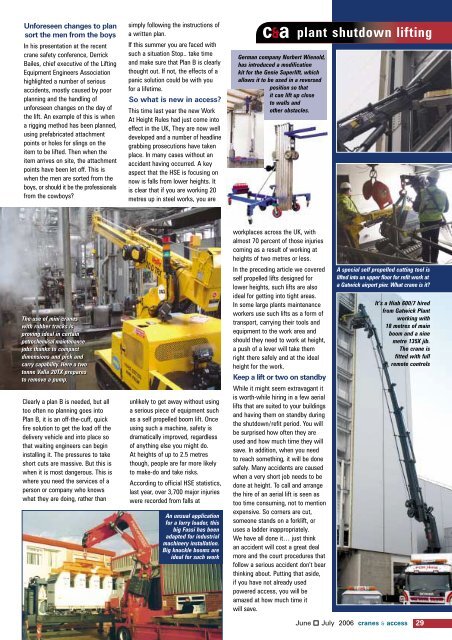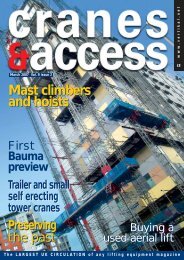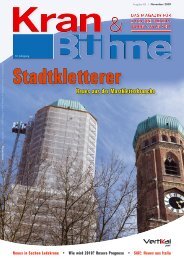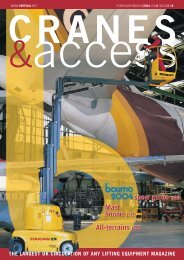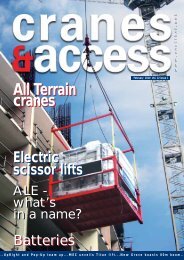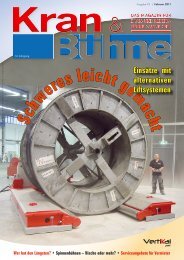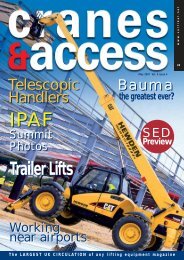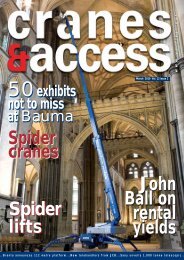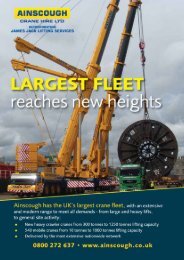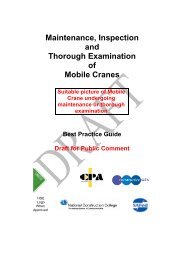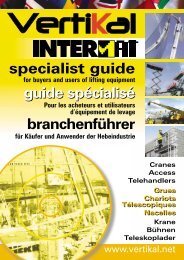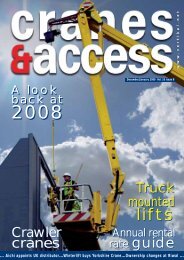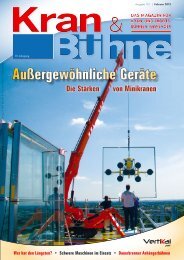Create successful ePaper yourself
Turn your PDF publications into a flip-book with our unique Google optimized e-Paper software.
Unforeseen changes to plan<br />
sort the men from the boys<br />
In his presentation at the recent<br />
crane safety conference, Derrick<br />
Bailes, chief executive of the Lifting<br />
Equipment Engineers Association<br />
highlighted a number of serious<br />
accidents, mostly caused by poor<br />
planning and the handling of<br />
unforeseen changes on the day of<br />
the lift. An example of this is when<br />
a rigging method has been planned,<br />
using prefabricated attachment<br />
points or holes for slings on the<br />
item to be lifted. Then when the<br />
item arrives on site, the attachment<br />
points have been let off. This is<br />
when the men are sorted from the<br />
boys, or should it be the professionals<br />
from the cowboys?<br />
The use of mini cranes<br />
with rubber tracks is<br />
proving ideal in certain<br />
petrochemical maintenance<br />
jobs thanks to compact<br />
dimensions and pick and<br />
carry capability. Here a two<br />
tonne Valla 20TX prepares<br />
to remove a pump.<br />
Clearly a plan B is needed, but all<br />
too often no planning goes into<br />
Plan B, it is an off-the-cuff, quick<br />
fire solution to get the load off the<br />
delivery vehicle and into place so<br />
that waiting engineers can begin<br />
installing it. The pressures to take<br />
short cuts are massive. But this is<br />
when it is most dangerous. This is<br />
where you need the services of a<br />
person or company who knows<br />
what they are doing, rather than<br />
simply following the instructions of<br />
a written plan.<br />
If this summer you are faced with<br />
such a situation Stop.. take time<br />
and make sure that Plan B is clearly<br />
thought out. If not, the effects of a<br />
panic solution could be with you<br />
for a lifetime.<br />
So what is new in access?<br />
This time last year the new Work<br />
At Height Rules had just come into<br />
effect in the UK, They are now well<br />
developed and a number of headline<br />
grabbing prosecutions have taken<br />
place. In many cases without an<br />
accident having occurred. A key<br />
aspect that the HSE is focusing on<br />
now is falls from lower heights. It<br />
is clear that if you are working 20<br />
metres up in steel works, you are<br />
unlikely to get away without using<br />
a serious piece of equipment such<br />
as a self propelled boom lift. Once<br />
using such a machine, safety is<br />
dramatically improved, regardless<br />
of anything else you might do.<br />
At heights of up to 2.5 metres<br />
though, people are far more likely<br />
to make-do and take risks.<br />
According to official HSE statistics,<br />
last year, over 3,700 major injuries<br />
were recorded from falls at<br />
An unsual application<br />
for a lorry loader, this<br />
big Fassi has been<br />
adapted for industrial<br />
machinery installation.<br />
Big knuckle booms are<br />
ideal for such work<br />
c&a<br />
German company Norbert Wienold,<br />
has introduced a modification<br />
kit for the Genie Superlift, which<br />
allows it to be used in a reversed<br />
position so that<br />
it can lift up close<br />
to walls and<br />
other obstacles.<br />
workplaces across the UK, with<br />
almost 70 percent of those injuries<br />
coming as a result of working at<br />
heights of two metres or less.<br />
In the preceding article we covered<br />
self propelled lifts designed for<br />
lower heights, such lifts are also<br />
ideal for getting into tight areas.<br />
In some large plants maintenance<br />
workers use such lifts as a form of<br />
transport, carrying their tools and<br />
equipment to the work area and<br />
should they need to work at height,<br />
a push of a lever will take them<br />
right there safely and at the ideal<br />
height for the work.<br />
Keep a lift or two on standby<br />
While it might seem extravagant it<br />
is worth-while hiring in a few aerial<br />
lifts that are suited to your buildings<br />
and having them on standby during<br />
the shutdown/refit period. You will<br />
be surprised how often they are<br />
used and how much time they will<br />
save. In addition, when you need<br />
to reach something, it will be done<br />
safely. Many accidents are caused<br />
when a very short job needs to be<br />
done at height. To call and arrange<br />
the hire of an aerial lift is seen as<br />
too time consuming, not to mention<br />
expensive. So corners are cut,<br />
someone stands on a forklift, or<br />
uses a ladder inappropriately.<br />
We have all done it… just think<br />
an accident will cost a great deal<br />
more and the court procedures that<br />
follow a serious accident don’t bear<br />
thinking about. Putting that aside,<br />
if you have not already used<br />
powered access, you will be<br />
amazed at how much time it<br />
will save.<br />
plant shutdown lifting<br />
A special self propelled cutting tool is<br />
lifted into an upper floor for refit work at<br />
a Gatwick airport pier. What crane is it?<br />
It’s a Hiab 600/7 hired<br />
from Gatwick Plant<br />
working with<br />
18 metres of main<br />
boom and a nine<br />
metre 135X jib.<br />
The crane is<br />
fitted with full<br />
remote controls<br />
June July 2006 cranes & access<br />
29


